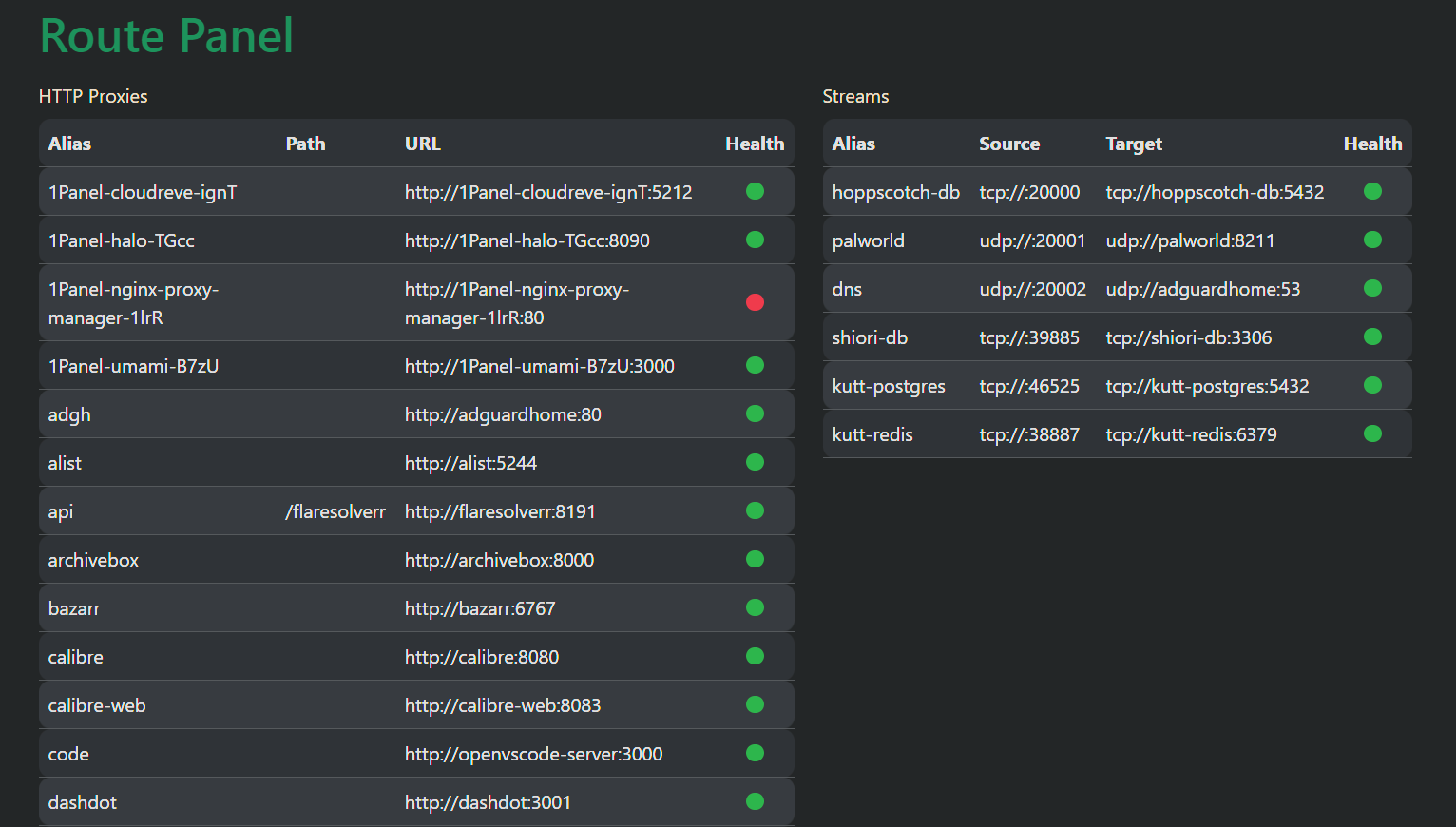7.8 KiB
Executable file
go-proxy
A simple auto docker reverse proxy for home use. Written in Go
In the examples domain x.y.z is used, replace them with your domain
Table of content
- Features
- Why am I making this
- How to use
- Configuration
- Troubleshooting
- Benchmarks
- Memory usage
- Build it yourself
- Getting SSL certs
Features
-
auto detect reverse proxies from docker
-
additional reverse proxies from provider yaml file
-
allow multiple docker / file providers by custom
config.ymlfile -
subdomain matching (domain name doesn't matter)
-
path matching
-
HTTP proxy
-
TCP/UDP Proxy
-
HTTP round robin load balance support (same subdomain and path across containers replicas)
-
Auto hot-reload when container start / die / stop.
-
Simple panel to see all reverse proxies and health (visit port panel port of go-proxy
https://*.y.z:[panel port])
Why am I making this
- It's fun.
- I have tried different reverse proxy services, i.e. nginx proxy manager, traefik, nginx-proxy. I have found that
traefikis not easy to use, and I don't want to click buttons every time I spin up a new container (nginx proxy manager). Fornginx-proxyI found it buggy and quite unusable.
How to use
-
Download and extract the latest release
-
Copy content from compose.example.yml and create your own
compose.yml -
Add networks to make sure it is in the same network with other containers, or make sure
proxy.<alias>.hostis reachable -
(Optional) Mount your SSL certs. See Getting SSL Certs
-
Start
go-proxywithdocker compose up -dormake up. -
(Optional) If you are using ufw with vpn that drop all inbound traffic except vpn, run below to allow docker containers to connect to
go-proxyIn case the network of your container is in subnet
172.16.0.0/16(bridge), and vpn network is under100.64.0.0/10(i.e. tailscale)sudo ufw allow from 172.16.0.0/16 to 100.64.0.0/10You can also list CIDRs of all docker bridge networks by:
docker network inspect $(docker network ls | awk '$3 == "bridge" { print $1}') | jq -r '.[] | .Name + " " + .IPAM.Config[0].Subnet' - -
start your docker app, and visit <container_name>.y.z
-
check the logs with
docker compose logsormake logsto see if there is any error, check panel at panel port for active proxies
Known issues
None
Configuration
With container name, no label needs to be added.
However, there are some labels you can manipulate with:
-
proxy.aliases: comma separated aliases for subdomain matching- defaults to
container_name
- defaults to
-
proxy.<alias>.scheme: container port protocol (httporhttps)- defaults to
http
- defaults to
-
proxy.<alias>.host: proxy host- defaults to
container_name
- defaults to
-
proxy.<alias>.port: proxy port- http/https: defaults to first expose port (declared in
Dockerfileordocker-compose.yml) - tcp/udp: is in format of
[<listeningPort>:]<targetPort>- when
listeningPortis omitted (not suggested), a free port will be used automatically. targetPortmust be a number, or the predefined names (see stream.go)
- when
- http/https: defaults to first expose port (declared in
-
proxy.<alias>.path: path matching (for http proxy only)- defaults to empty
-
proxy.<alias>.path_mode: mode for path handling- defaults to empty
- allowed: <empty>, forward, sub
- empty: remove path prefix from URL when proxying
- apps.y.z/webdav -> webdav:80
- apps.y.z./webdav/path/to/file -> webdav:80/path/to/file
- forward: path remain unchanged
- apps.y.z/webdav -> webdav:80/webdav
- apps.y.z./webdav/path/to/file -> webdav:80/webdav/path/to/file
- sub: (experimental) remove path prefix from URL and also append path to HTML link attributes (
src,hrefandaction) and Javascriptfetch(url)by response body substitution e.g. apps.y.z/app1 -> webdav:80,href="/path/to/file"->href="/app1/path/to/file"
- empty: remove path prefix from URL when proxying
-
proxy.<alias>.load_balance: enable load balance- allowed:
1,true
- allowed:
Single port configuration example
# (default) https://<container_name>.y.z
whoami:
image: traefik/whoami
container_name: whoami # => whoami.y.z
# enable both subdomain and path matching:
whoami:
image: traefik/whoami
container_name: whoami
labels:
- proxy.aliases=whoami,apps
- proxy.apps.path=/whoami
# 1. visit https://whoami.y.z
# 2. visit https://apps.y.z/whoami
Multiple ports configuration example
minio:
image: quay.io/minio/minio
container_name: minio
...
labels:
- proxy.aliases=minio,minio-console
- proxy.minio.port=9000
- proxy.minio-console.port=9001
# visit https://minio.y.z to access minio
# visit https://minio-console.y.z/whoami to access minio console
TCP/UDP configuration example
# In the app
app-db:
image: postgres:15
container_name: app-db
...
labels:
# Optional (postgres is in the known image map)
- proxy.app-db.scheme=tcp
# Optional (first free port will be used for listening port)
- proxy.app-db.port=20000:postgres
# In go-proxy
go-proxy:
...
ports:
- 80:80
...
- 20000:20000/tcp
# or 20000-20010:20000-20010/tcp to declare large range at once
# access app-db via <*>.y.z:20000
Load balancing Configuration Example
nginx:
...
deploy:
mode: replicated
replicas: 3
labels:
- proxy.nginx.load_balance=1 # allowed: [1, true]
Troubleshooting
Q: How to fix when it shows "no matching route for subdomain <subdomain>"?
A: Make sure the container is running, and <subdomain> matches any container name / alias
Benchmarks
Benchmarked with wrk connecting traefik/whoami's /bench endpoint
Direct connection
% wrk -t20 -c100 -d10s --latency http://homelab:4999/bench
Running 10s test @ http://homelab:4999/bench
20 threads and 100 connections
Thread Stats Avg Stdev Max +/- Stdev
Latency 3.74ms 1.19ms 19.94ms 81.53%
Req/Sec 1.35k 103.96 1.60k 73.60%
Latency Distribution
50% 3.46ms
75% 4.16ms
90% 4.98ms
99% 8.04ms
269696 requests in 10.01s, 32.41MB read
Requests/sec: 26950.35
Transfer/sec: 3.24MB
With go-proxy reverse proxy
% wrk -t20 -c100 -d10s --latency https://whoami.mydomain.com/bench
Running 10s test @ https://whoami.6uo.me/bench
20 threads and 100 connections
Thread Stats Avg Stdev Max +/- Stdev
Latency 4.02ms 2.13ms 47.49ms 95.14%
Req/Sec 1.28k 139.15 1.47k 91.67%
Latency Distribution
50% 3.60ms
75% 4.36ms
90% 5.29ms
99% 8.83ms
253874 requests in 10.02s, 24.70MB read
Requests/sec: 25342.46
Transfer/sec: 2.47MB
Memory usage
It takes ~ 0.1-0.4MB for each HTTP Proxy, and <2MB for each TCP/UDP Proxy
Build it yourself
-
Install go and
makeif not already -
get dependencies with
make get -
build binary with
make build -
start your container with
docker compose up -d
Getting SSL certs
I personally use nginx-proxy-manager to get SSL certs with auto renewal by Cloudflare DNS challenge. You may symlink the certs from nginx-proxy-manager to somewhere else, and mount them to go-proxy's /certs
